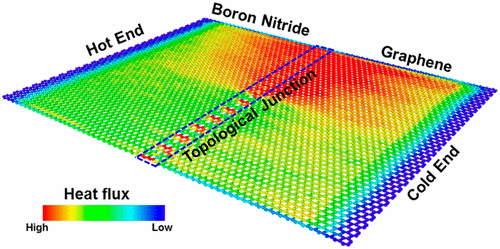当前位置:
X-MOL 学术
›
ACS Appl. Mater. Interfaces
›
论文详情
Our official English website, www.x-mol.net, welcomes your
feedback! (Note: you will need to create a separate account there.)
Controllable Interface Junction, In-Plane Heterostructures Capable of Mechanically Mediating On-Demand Asymmetry of Thermal Transports
ACS Applied Materials & Interfaces ( IF 8.3 ) Pub Date : 2017-09-22 00:00:00 , DOI: 10.1021/acsami.7b11508 Yuan Gao 1 , Baoxing Xu 1
ACS Applied Materials & Interfaces ( IF 8.3 ) Pub Date : 2017-09-22 00:00:00 , DOI: 10.1021/acsami.7b11508 Yuan Gao 1 , Baoxing Xu 1
Affiliation

|
Designing structures with thermal rectification performance that can be regulated by or adapted to mechanical deformation is in great demand in wearable electronics. Herein, using nonequilibrium molecular dynamics simulation, we present an in-plane graphene-boron nitride heterostructure with a controlled interface junction and demonstrate that its thermal transport ability is asymmetric when reversing the direction of heat flow. Such thermal rectification performance can be further regulated by applying an external tensile loading due to the mitigation of stress concentration, phonon resonance, and phonon localization. The analyses on heat flow distribution, vibrational spectra, and phonon participation suggest that the out-of-plane phonon modes dominate thermal rectification at a small tensile strain, while the mechanical stress plays a dominant role in regulation at a large tensile strain due to the weakened localization of out-of-plane phonon modes. The effect of tensile loading on the thermal rectification is demonstrated by selective interface junction-enabled heterostructures, and the results indicate that both asymmetry and direction of thermal transport can be controlled by introducing defects to the interface junction and/or applying mechanical tensile strain. These findings and models are expected to provide an immediate guidance for designing and manufacturing 2D material-based devices with mechanically tunable thermal management capabilities.
中文翻译:

可控界面连接,平面内异质结构,能够以机械方式介导热传输的按需不对称性
在可穿戴电子设备中,对具有可通过机械变形来调节或适应于机械变形的热整流性能的结构的设计提出了很高的要求。在本文中,使用非平衡分子动力学模拟,我们提出了一种具有受控界面结的面内石墨烯-氮化硼异质结构,并证明了当热流方向逆转时,其传热能力是不对称的。由于减轻了应力集中,声子共振和声子局部化,可通过施加外部拉伸载荷来进一步调节这种热整流性能。对热流分布,振动谱和声子参与的分析表明,平面外声子模式在较小的拉伸应变下主导着热整流,而由于平面外声子模式的弱化,机械应力在大拉伸应变的调节中起主要作用。选择性界面结使能的异质结构证明了拉伸载荷对热精馏的影响,结果表明,可以通过在界面结处引入缺陷和/或施加机械拉伸应变来控制热传递的不对称性和方向。这些发现和模型有望为具有机械可调热管理功能的2D基于材料的设备的设计和制造提供即时指导。选择性界面结使能的异质结构证明了拉伸载荷对热精馏的影响,结果表明,可以通过在界面结处引入缺陷和/或施加机械拉伸应变来控制热传递的不对称性和方向。这些发现和模型有望为具有机械可调热管理功能的2D基于材料的设备的设计和制造提供即时指导。选择性界面结使能的异质结构证明了拉伸载荷对热精馏的影响,结果表明,可以通过在界面结处引入缺陷和/或施加机械拉伸应变来控制热传递的不对称性和方向。这些发现和模型有望为具有机械可调热管理功能的2D基于材料的设备的设计和制造提供即时指导。
更新日期:2017-09-23
中文翻译:

可控界面连接,平面内异质结构,能够以机械方式介导热传输的按需不对称性
在可穿戴电子设备中,对具有可通过机械变形来调节或适应于机械变形的热整流性能的结构的设计提出了很高的要求。在本文中,使用非平衡分子动力学模拟,我们提出了一种具有受控界面结的面内石墨烯-氮化硼异质结构,并证明了当热流方向逆转时,其传热能力是不对称的。由于减轻了应力集中,声子共振和声子局部化,可通过施加外部拉伸载荷来进一步调节这种热整流性能。对热流分布,振动谱和声子参与的分析表明,平面外声子模式在较小的拉伸应变下主导着热整流,而由于平面外声子模式的弱化,机械应力在大拉伸应变的调节中起主要作用。选择性界面结使能的异质结构证明了拉伸载荷对热精馏的影响,结果表明,可以通过在界面结处引入缺陷和/或施加机械拉伸应变来控制热传递的不对称性和方向。这些发现和模型有望为具有机械可调热管理功能的2D基于材料的设备的设计和制造提供即时指导。选择性界面结使能的异质结构证明了拉伸载荷对热精馏的影响,结果表明,可以通过在界面结处引入缺陷和/或施加机械拉伸应变来控制热传递的不对称性和方向。这些发现和模型有望为具有机械可调热管理功能的2D基于材料的设备的设计和制造提供即时指导。选择性界面结使能的异质结构证明了拉伸载荷对热精馏的影响,结果表明,可以通过在界面结处引入缺陷和/或施加机械拉伸应变来控制热传递的不对称性和方向。这些发现和模型有望为具有机械可调热管理功能的2D基于材料的设备的设计和制造提供即时指导。











































 京公网安备 11010802027423号
京公网安备 11010802027423号